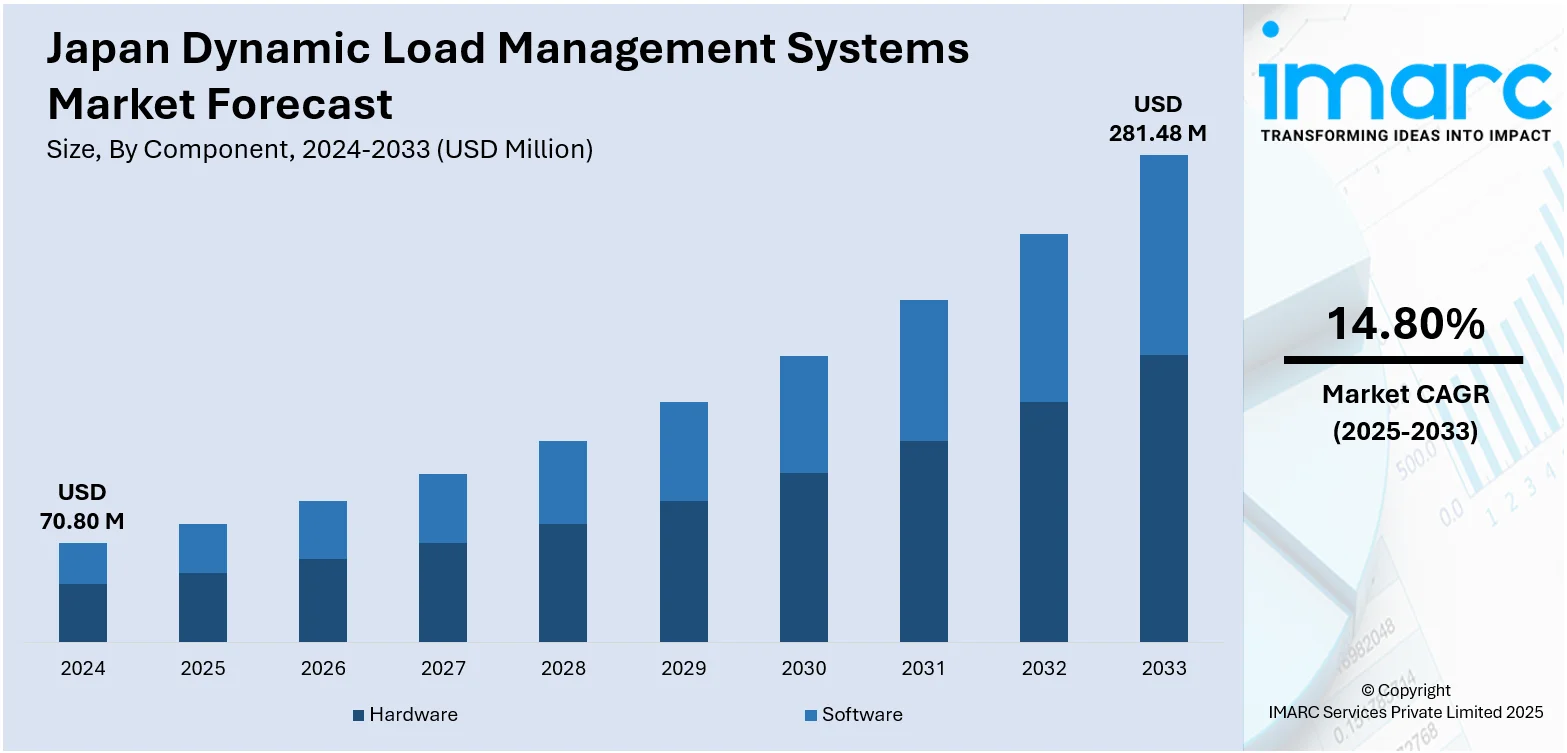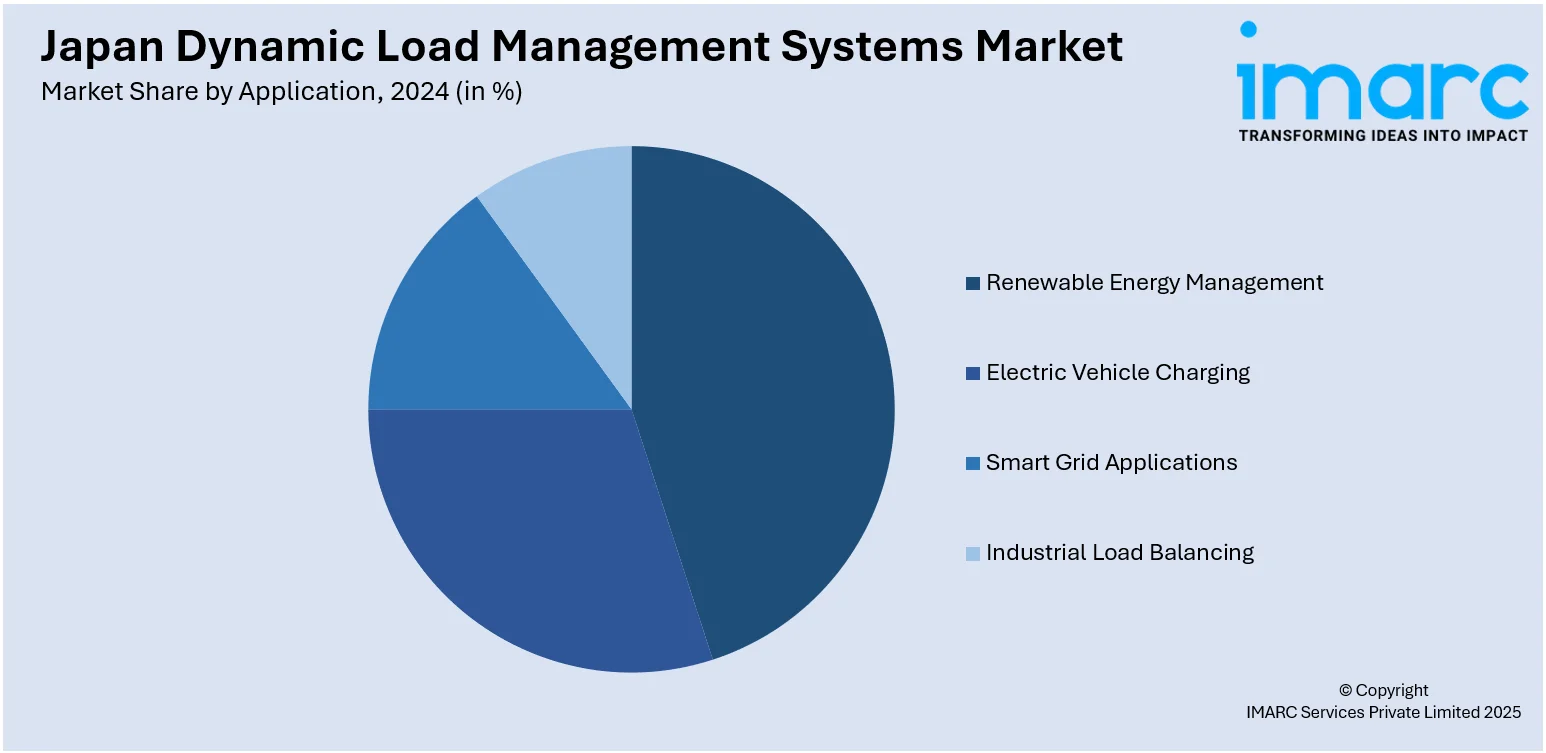
Japan Dynamic Load Management Systems Market Size, Share, Trends and Forecast by Component, Application, Technology, Deployment Mode, End User, and Region, 2025-2033
Japan Dynamic Load Management Systems Market Overview:
The Japan dynamic load management systems market size reached USD 70.80 Million in 2024. Looking forward, IMARC Group expects the market to reach USD 281.48 Million by 2033, exhibiting a growth rate (CAGR) of 14.80% during 2025-2033. The market is growing due to rising demand for energy-efficient electric mobility and intelligent electric vehicle charging infrastructure. In line with this, the increased focus on smart battery integration and real-time energy distribution continues to support Japan dynamic load management systems market share across the transport, residential, and commercial energy sectors.
|
Report Attribute
|
Key Statistics
|
|---|---|
|
Base Year
|
2024
|
|
Forecast Years
|
2025-2033
|
|
Historical Years
|
2019-2024
|
| Market Size in 2024 | USD 70.80 Million |
| Market Forecast in 2033 | USD 281.48 Million |
| Market Growth Rate 2025-2033 | 14.80% |
Japan Dynamic Load Management Systems Market Trends:
Battery Efficiency in Light Electric Mobility
The market in Japan is increasingly shaped by the demand for power-efficient solutions in small electric vehicles. Moreover, there is growing pressure to optimize battery use while maintaining optimal performance with the rising adoption of batteries in commercial facilities, campuses, and resorts. Manufacturers are focusing on reducing energy loss, extending battery life, and improving motor control in compact formats. For instance, in March 2025, Yamaha responded to this need by launching electric golf carts featuring in-house-developed LFP battery technology and high-precision AC motors. Furthermore, these vehicles offered a 30% reduction in power consumption compared to previous models, supporting improved load balancing and enhanced battery health in light-duty electric transport. The integration of regenerative braking and brushless motor design enhanced the vehicles' efficiency in varied use conditions, reflecting a broader shift toward smarter onboard energy management. This type of development is helping redefine how dynamic load control is applied to small electric platforms, making them more adaptable for continuous daily use. As demand for low-voltage electric vehicles grows, the focus on built-in load management is becoming a key factor, encouraging more innovation in vehicle electronics and creating new momentum in Japan's dynamic load management ecosystem for mobility solutions.

To get more information on this market, Request Sample
Smart Charging Integration Across Sectors
Japan dynamic load management systems market growth is being influenced by the need for more intelligent, connected EV charging infrastructure. As electric vehicles expand beyond personal use into workplaces and commercial fleets, energy distribution must adapt to meet higher, more complex loads without straining the grid. This is driving strong interest in systems that can manage varying demands in real-time across multiple points of use. Aligned with this trend, in May 2025, Dahua Technology introduced its D-Volt EV charging platform at Power2Drive Europe, offering dynamic load balancing for residential, workplace, and public environments. The system featured smart current adjustment, solar integration, and cloud-based control tools, helping users avoid overloads and optimize energy use across multiple chargers. Also, D-Volt created a more flexible framework for high-efficiency charging by integrating intelligent load distribution with user apps and centralized platforms. This aligns with broader efforts in Japan to decentralize load management and apply smart controls across infrastructure layers. The push for scalable, adaptive EV charging is reinforcing demand for real-time load management capabilities, helping support growing energy needs without requiring major grid overhauls. As a result, intelligent EV charging systems are becoming key drivers in expanding Japan's dynamic load management capacity.
Japan Dynamic Load Management Systems Market Segmentation:
IMARC Group provides an analysis of the key trends in each segment of the market, along with forecasts at the country and regional level for 2025-2033. Our report has categorized the market based on component, application, technology, deployment mode, and end user.
Component Insights:
- Hardware
- Software
The report has provided a detailed breakup and analysis of the market based on the component. This includes hardware and software.
Application Insights:

- Renewable Energy Management
- Electric Vehicle Charging
- Smart Grid Applications
- Industrial Load Balancing
The report has provided a detailed breakup and analysis of the market based on the application. This includes renewable energy management, electric vehicle charging, smart grid applications, and industrial load balancing.
Technology Insights:
- Cloud-based Solutions
- IoT-enabled Devices
- Artificial Intelligence Integration
The report has provided a detailed breakup and analysis of the market based on the technology. This includes cloud-based solutions, IoT-enabled devices, and artificial intelligence integration.
Deployment Mode Insights:
- On-premises
- Cloud-based Deployment
- Hybrid Deployment
The report has provided a detailed breakup and analysis of the market based on the deployment mode. This includes on-premises, cloud-based deployment, and hybrid deployment.
End User Insights:
- Residential
- Commercial
- Industrial
The report has provided a detailed breakup and analysis of the market based on the end user. This includes residential, commercial, and industrial.
Regional Insights:
- Kanto Region
- Kansai/Kinki Region
- Central/ Chubu Region
- Kyushu-Okinawa Region
- Tohoku Region
- Chugoku Region
- Hokkaido Region
- Shikoku Region
The report has also provided a comprehensive analysis of all the major regional markets, which include Kanto Region, Kansai/Kinki Region, Central/ Chubu Region, Kyushu-Okinawa Region, Tohoku Region, Chugoku Region, Hokkaido Region, and Shikoku Region.
Competitive Landscape:
The market research report has also provided a comprehensive analysis of the competitive landscape. Competitive analysis such as market structure, key player positioning, top winning strategies, competitive dashboard, and company evaluation quadrant has been covered in the report. Also, detailed profiles of all major companies have been provided.
Japan Dynamic Load Management Systems Market News:
- June 2025: Yokogawa launched CENTUM VP Release 7 in Japan, integrating predictive monitoring and autonomous control AI for dynamic load management. This upgrade enhanced plant-wide energy efficiency, reduced operator workload, and strengthened Japan’s market for intelligent, secure, and autonomous load management solutions in industrial operations.
- May 2025: NYK introduced Japan’s first fully battery-powered work vessel, e-Crea, without diesel backup, relying solely on shore-charged power. This milestone supported dynamic load management in marine operations, improved energy control, and advanced Japan’s market shift toward zero-emission, battery-integrated maritime infrastructure.
Japan Dynamic Load Management Systems Market Report Coverage:
| Report Features | Details |
|---|---|
| Base Year of the Analysis | 2024 |
| Historical Period | 2019-2024 |
| Forecast Period | 2025-2033 |
| Units | Million USD |
| Scope of the Report |
Exploration of Historical Trends and Market Outlook, Industry Catalysts and Challenges, Segment-Wise Historical and Future Market Assessment:
|
| Components Covered | Hardware, Software |
| Applications Covered | Renewable Energy Management, Electric Vehicle Charging, Smart Grid Applications, Industrial Load Balancing |
| Technologies Covered | Cloud-based Solutions, IoT-enabled Devices, Artificial Intelligence Integration |
| Deployment Modes Covered | On-premises, Cloud-based Deployment, Hybrid Deployment |
| End Users Covered | Residential, Commercial, Industrial |
| Regions Covered | Kanto Region, Kansai/Kinki Region, Central/ Chubu Region, Kyushu-Okinawa Region, Tohoku Region, Chugoku Region, Hokkaido Region, Shikoku Region |
| Customization Scope | 10% Free Customization |
| Post-Sale Analyst Support | 10-12 Weeks |
| Delivery Format | PDF and Excel through Email (We can also provide the editable version of the report in PPT/Word format on special request) |
Key Questions Answered in This Report:
- How has the Japan dynamic load management systems market performed so far and how will it perform in the coming years?
- What is the breakup of the Japan dynamic load management systems market on the basis of component?
- What is the breakup of the Japan dynamic load management systems market on the basis of application?
- What is the breakup of the Japan dynamic load management systems market on the basis of technology?
- What is the breakup of the Japan dynamic load management systems market on the basis of deployment mode?
- What is the breakup of the Japan dynamic load management systems market on the basis of end user?
- What is the breakup of the Japan dynamic load management systems market on the basis of region?
- What are the various stages in the value chain of the Japan dynamic load management systems market?
- What are the key driving factors and challenges in the Japan dynamic load management systems market?
- What is the structure of the Japan dynamic load management systems market and who are the key players?
- What is the degree of competition in the Japan dynamic load management systems market?
Key Benefits for Stakeholders:
- IMARC’s industry report offers a comprehensive quantitative analysis of various market segments, historical and current market trends, market forecasts, and dynamics of the Japan dynamic load management systems market from 2019-2033.
- The research report provides the latest information on the market drivers, challenges, and opportunities in the Japan dynamic load management systems market.
- Porter's five forces analysis assist stakeholders in assessing the impact of new entrants, competitive rivalry, supplier power, buyer power, and the threat of substitution. It helps stakeholders to analyze the level of competition within the Japan dynamic load management systems industry and its attractiveness.
- Competitive landscape allows stakeholders to understand their competitive environment and provides an insight into the current positions of key players in the market.
Need more help?
- Speak to our experienced analysts for insights on the current market scenarios.
- Include additional segments and countries to customize the report as per your requirement.
- Gain an unparalleled competitive advantage in your domain by understanding how to utilize the report and positively impacting your operations and revenue.
- For further assistance, please connect with our analysts.
 Request Customization
Request Customization
 Speak to an Analyst
Speak to an Analyst
 Request Brochure
Request Brochure
 Inquire Before Buying
Inquire Before Buying




.webp)




.webp)












